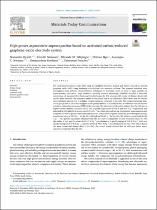High power asymmetric supercapacitor based on activated carbon/reduced graphene oxide electrode system
| dc.contributor.author | Dywili, Nomxolisi | |
| dc.contributor.author | Ntziouni, Afroditi | |
| dc.contributor.author | Ndipingwi, Miranda M. | |
| dc.contributor.author | Ikpo, Chinwe | |
| dc.contributor.author | Nwanya, Assumpta C. | |
| dc.contributor.author | Kordatos, Konstantinos | |
| dc.contributor.author | Iwuoha, Emmanuel | |
| dc.date.accessioned | 2023-03-30T10:30:38Z | |
| dc.date.available | 2023-03-30T10:30:38Z | |
| dc.date.issued | 2023-02-22 | |
| dc.identifier.citation | Dywili, Ntziouni, A., Ndipingwi, M. M., Ikpo, C., Nwanya, A. C., Kordatos, K., & Iwuoha, E. (2023). High power asymmetric supercapacitor based on activated carbon/reduced graphene oxide electrode system. Materials Today Communications, 35. https://doi.org/10.1016/j.mtcomm.2023.105653 | en_US |
| dc.identifier.issn | 2352-4928 | |
| dc.identifier.uri | http://hdl.handle.net/10566/8715 | |
| dc.description.abstract | We synthesized Graphene oxide (GO) using the modified Hummers method and further reduced to reduced graphene oxide (rGO) using hydrazine monohydrate and ammonia solution. The prepared materials were interrogated using different characterization techniques to determine which of them is more suitable for supercapacitor application. High resolution scanning electron microscopy (HRSEM) revealed a sheet-like morphology of separated thin sheets and wrinkled edges for GO, whereas rGO consist of thinner sheets with smaller pores than GO. The structural studies as elucidated from X-ray diffraction (XRD) shows that the GO has more interlayer spacing due to a higher oxygen content as compared to the rGO. The oxygen containing functional groups seen in GO either disappear or are greatly reduced in intensity in rGO as evidenced from the Fourier transform infrared spectroscopy (FTIR) of the materials. The electrochemical studies indicate that the rGO gave a higher current response compared to GO and a specific capacitance of 105.3 and 56.7 F g 1 respectively was delivered by rGO and GO at a scan rate of 10 mV s 1 in a three-electrode set-up. Asymmetric supercapacitor cells using GO and rGO as positive electrodes and activated carbon as the negative electrodes gave the highest specific capacitance value of 94.3 F g 1 for the AC//rGO cell and 59.6 F g 1 for the AC//GO cell at a current load of 0.25 A g 1. The specific capacitance obtained from the AC//rGO is comparable to most recorded values for rGO electrodes. A high specific power of 6411.7 W kg 1 was obtained at a specific energy of 22.6 W h kg 1 while at a specific energy of 25.7 W h kg 1, a specific power of 700.1 W kg 1 was obtained for the AC//rGO. This is due to the more porous and thinner sheet of the rGO. The overall results showed that the rGO gave better supercapacitive properties than the GO. | en_US |
| dc.publisher | Elsevier | en_US |
| dc.subject | Energy storage | en_US |
| dc.subject | Graphene | en_US |
| dc.subject | Graphene oxide | en_US |
| dc.subject | Reduced graphene oxide | en_US |
| dc.subject | Supercapacitor | en_US |
| dc.title | High power asymmetric supercapacitor based on activated carbon/reduced graphene oxide electrode system | en_US |
| dc.type | Article | en_US |

